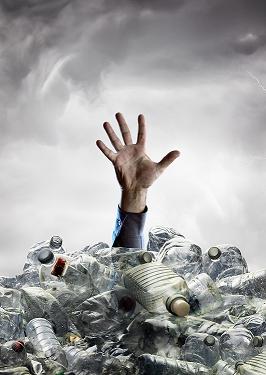On World Environment Day, celebrated on June 5, 3Love Inc. wants to raise awareness about plastic pollution, which is one of the most serious environmental threats facing the Earth.
According to the United Nations Environment Programme (UNEP), humanity generated approximately 400 million tons of plastic waste last year. This avalanche of water bottles, shampoo bottles, dispenser containers, PVC pipes, and other plastic products is part of a plastic pollution crisis that is affecting ecosystems, exposing people to potentially harmful contaminants, and exacerbating climate change.
For this reason, we want to share 10 facts about plastic pollution to better understand why it is such a serious problem.
- How much plastic is there in the world?
Today, plastics are a fundamental part of the modern world and are used in all kinds of products, from car parts to medical devices. Since the 1950s, humanity has produced around 9.2 billion tons of plastic, of which around 7 billion tons have become waste.
- Which types of plastics are the most problematic?
One of the main sources of plastic pollution is single-use plastic products, such as water bottles, dispenser containers, food bags, disposable cutlery, freezer bags, and packaging foam. All of these overload waste management systems and enter the environment.
- Where is plastic pollution found?
It is everywhere: in lakes, rivers, and oceans. It litters city streets and farm fields. It overflows in landfills. It accumulates in deserts and infiltrates sea ice. Researchers have even found plastic debris on Mount Everest.
- Why is plastic pollution a problem?
Plastic pollution can wreak havoc on ecosystems. One study found that small plastic particles can slow the growth of microscopic seaweed known as phytoplankton, which is the basis of several aquatic food chains. In addition, fish often mistakenly ingest plastic products, filling their stomachs with indigestible fragments that cause them to die.
In addition, plastic often breaks down into tiny fragments that can accumulate in the human body. Microplastics have even been found in breast milk. One study found that a liter of bottled water contains around 240,000 microplastics.
Thirdly, plastic also contributes to climate change throughout its entire life cycle. Plastic production was responsible for more than 3% of the greenhouse gas emissions that warmed the planet in 2020.
- What do microplastics do to humans?
There is still no exact data, but researchers are working hard to find out due to the alarming amount of microplastics we are ingesting.
- Can recycling alone end the plastic pollution crisis?
No. Only about 9% of plastics are actually recycled, according to a study by the Organization for Economic Cooperation and Development. Many plastic products are not designed to be reused or recycled. Some are too fragile to be recycled, while others can only be recycled once or twice. Many countries lack the infrastructure to collect and recycle plastic waste. Another major problem is that recycling systems cannot keep up with the increase in plastic waste. Global plastic production doubled between 2000 and 2019.
- So how can plastic pollution be tackled?
We need to find ways to limit the environmental and health problems caused by plastic pollution. This involves analyzing each stage of a product’s life cycle, from production, design, and consumption to final disposal. This is known as the life cycle approach. In practical terms, it means reducing our dependence on single-use plastic products and redesigning plastic products to last longer, be less hazardous, be reusable, and ultimately be recyclable.
- Is this process expensive and complicated?
Not necessarily. Governments, businesses, non-profit organizations, and individuals around the world are already implementing innovative solutions to end plastic pollution. And research suggests that the life cycle approach could save the world US$4.5 trillion in social and environmental costs by 2040.
- What is the world doing to combat plastic pollution?
Many countries are tackling pollution at the national level with laws designed to curb the use of single-use plastic products. However, since plastic pollution is a cross-border issue, international cooperation is crucial. That is why several countries are currently negotiating a global treaty to end plastic pollution.
- Why is there such urgency to address plastic pollution?
Without decisive action, the problem of plastic pollution will only get worse. The Organization for Economic Cooperation and Development predicts that by 2060, plastic waste will nearly triple, reaching 1 billion tons per year. If current trends continue, this will lead to an increase in plastic pollution.


